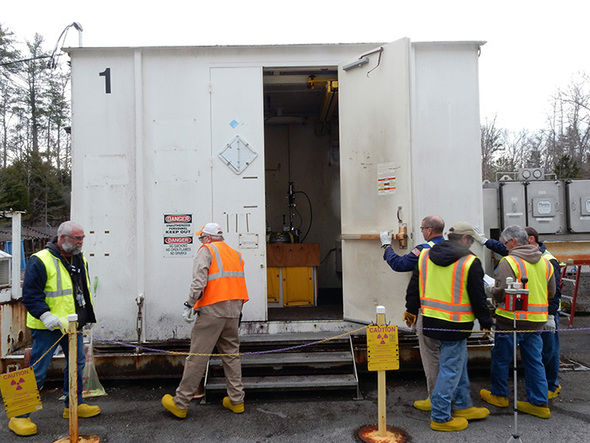
An aerial view of the Transuranic Waste Processing Center in west Oak Ridge, where the final drums of legacy transuranic waste stored at Oak Ridge National Laboratory will be processed before shipment to the Waste Isolation Pilot Plant in New Mexico for permanent disposal. (Photo courtesy U.S. Department of Energy Office of Environmental Management)
The final drums of old transuranic waste stored at Oak Ridge National Laboratory have been prepared for disposal.
The U.S. Department of Energy’s Oak Ridge Office of Environmental Management reported Tuesday that it had recently completed installing vents and sample ports in the final drums of the legacy transuranic waste stored at ORNL. The decade-long effort ensures that the drums do not contain any hazardous gases that could cause rapid combustion.
The ventilated unit where the drums were vented is closed and explosion-proof, DOE said. It is capable of withstanding a combustion event while keeping workers and ORNL, the nation’s largest multi-program national laboratory, safe, DOE said.
“Venting and sampling these drums is an essential part of the waste disposal process,” ORNL Portfolio Federal Project Director Bill McMillan said. “Now that we can ensure the safety of each drum, they are ready for transport to the Transuranic Waste Processing Center for processing and subsequent shipment to a permanent disposal facility away from Oak Ridge.”
Transuranic waste is contaminated with elements heavier than uranium.
Workers placed the drums of transuranic waste in the reinforced unit and installed vents and sample ports remotely. The ports allowed staff to determine if hydrogen existed in the drums. If high levels were detected, DOE said, crews moved those drums to a hydrogen diffusion area for monitoring until the levels naturally reached safe limits.
Past ORNL operations generated a large volume of transuranic waste over the decades. Workers placed the waste in containers and stored them in underground vaults and warehouses awaiting eventual disposition. New waste is placed in vented containers, but the legacy containers were designed differently, prompting the installation of drum vents and sample ports.
DOE said more than 4,000 containers have gone through the venting process in Oak Ridge since 2005. Only 67 containers remained to install vents in the most recent campaign. DOE’s Oak Ridge Office of Environmental Management and its cleanup contractor, URS | CH2M Oak Ridge, or UCOR, retrieved them from an underground storage vault last fall.
Much of the transuranic waste is composed of items such as beakers, gloves, and other lab equipment, DOE said.
After crews process the drums at the TWPC, they will eventually be transported to the Waste Isolation Pilot Plant, or WIPP, near Carlsbad, New Mexico for final disposal. The Transuranic Waste Processing Center is in west Oak Ridge, south of Bethel Valley Road on Highway 95.
This information was originally published in the “EM Update” electronic newsletter by the U.S. Department of Energy Office of Environmental Management on Tuesday, April 24. Contributors: Wayne McKinney, Ben Williams

Workers prepare to install vents in drums of legacy transuranic waste in a closed, explosion-proof, high-efficiency particulate air-ventilated unit to ensure safety of workers and the environment. (Photo courtesy U.S. Department of Energy Office of Environmental Management)
Background on shipments from Transuranic Waste Processing Center to WIPP: The Oak Ridge Office of Environmental Management reported in August that Oak Ridge had made its first transuranic waste shipment from the Transuranic Waste Processing Center to WIPP in five years, since 2012.
The Oak Ridge site, which has been open more than a dozen years, treats legacy transuranic waste that has been in storage for many years at Oak Ridge National Laboratory. That includes lab equipment or materials from research and development at ORNL and personal protective equipment. Some of the radioactive materials are handled remotely and others in glove boxes.
Transuranic waste consists of materials and debris that are contaminated with elements that have a higher atomic mass and listed after uranium on the periodic table. The majority of Oak Ridge’s inventory originated from previous research and isotope production missions at Oak Ridge National Laboratory.
Originally, much of the site’s transuranic waste was scheduled for shipment in 2014. However, weeks before shipments started, two events occurred at WIPP in February 2014—a truck fire and an unrelated radiological event—that suspended waste disposal operations. These operations resumed in January 2017, and WIPP began receiving shipments from select sites across the U.S. Department of Energy complex.
WIPP is the only facility in the U.S. that permanently disposes of transuranic waste, or TRU waste. Waste is disposed at WIPP in shafts, or drifts, about a half-mile below ground in an ancient salt bed.
See previous stories on transuranic waste here.
More information will be added as it becomes available.

For the first time since 2012, transuranic waste processed and treated in Oak Ridge was leaving the Transuranic Waste Processing Center for permanent disposal at the Waste Isolation Pilot Plant near Carlsbad, New Mexico, the U.S. Department of Energy reported in August 2017. A waste shipment is pictured above leaving Oak Ridge. (File photo courtesy U.S. Department of Energy Oak Ridge Office of Environmental Management)

A worker manipulates remote-handled waste at the TRU Waste Processing Center in west Oak Ridge. (Photo courtesy Oak Ridge Site Specific Advisory Board)
Do you appreciate this story or our work in general? If so, please consider a monthly subscription to Oak Ridge Today. See our Subscribe page here. Thank you for reading Oak Ridge Today.
Copyright 2018 Oak Ridge Today. All rights reserved. This material may not be published, broadcast, rewritten, or redistributed.
Leave a Reply